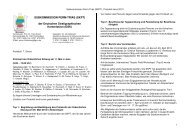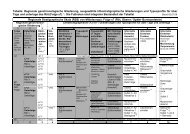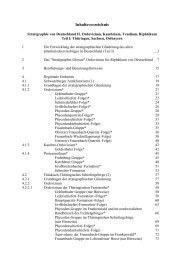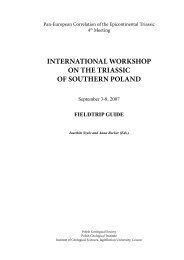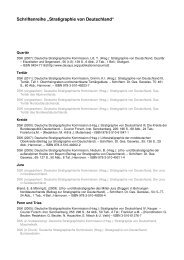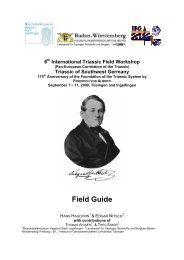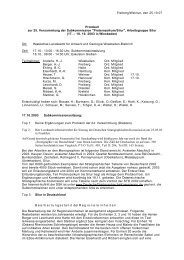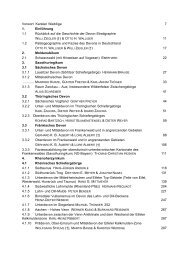International Field Workshop on 'The Triassic of eastern France'
International Field Workshop on 'The Triassic of eastern France'
International Field Workshop on 'The Triassic of eastern France'
You also want an ePaper? Increase the reach of your titles
YUMPU automatically turns print PDFs into web optimized ePapers that Google loves.
supported by the occurrence <strong>of</strong> bioturbati<strong>on</strong>. The interbedded aeolian sand sheets, sometimes bioturbated,<br />
and mud-crack structures indicate frequent subaerial exposure. The occurrence <strong>of</strong> sheet flood deposits,<br />
aeolian sand-sheets and mudcracks in fine-grained sediments point to an ephemeral hydrologically-closed<br />
lake formed under arid c<strong>on</strong>diti<strong>on</strong> (Rogers and Astin, 1991). This facies associati<strong>on</strong> characterizes fluvio-<br />
aeolian overbank envir<strong>on</strong>ments.<br />
Stop 4.5 - Niedersteinbach (forest trail): Permian (‘French Lower Buntsandstein’<br />
(‘Grès d'Annweiler’ Fm.) <strong>on</strong> Rotliegends)<br />
In this outcrop (See p. 7 for locati<strong>on</strong>), just at the western end <strong>of</strong> Niedersteinbach, the 'French Lower<br />
Buntsandstein' is represented by the ‘Grès d’Annweiler’. In the regi<strong>on</strong> <strong>of</strong> the ep<strong>on</strong>yme locality, north <strong>of</strong><br />
Wissembourg, the basal part <strong>of</strong> the formati<strong>on</strong> yielded a marine malac<strong>of</strong>auna typical <strong>of</strong> the Zechstein I; thus<br />
the 'French Lower Buntsandstein' is Permian in age. The lith<strong>of</strong>acies are very similar to those <strong>of</strong> the ‘Couches<br />
intermédiaires’.<br />
Stop 4.6 - Fleckenstein Castle: ‘Grès d'Annweiler’ Fm. and Trifels facies <strong>of</strong> the ‘Grès<br />
vosgien’ Fm<br />
The lowermost fluvial c<strong>on</strong>glomerate facies associati<strong>on</strong> is located at the base <strong>of</strong> the Lower <strong>Triassic</strong>,<br />
characterizing the ‘C<strong>on</strong>glomérat basal’ Formati<strong>on</strong>. This formati<strong>on</strong>, well observed <strong>on</strong> well-logs, overlies the<br />
basement and is located in the western part <strong>of</strong> the basin. It is diachr<strong>on</strong>ous and represents the landward<br />
equivalent <strong>of</strong> the ‘Grès vosgiens’ Formati<strong>on</strong> (See stop 1.4). It corresp<strong>on</strong>ds to more proximal braided-river<br />
deposits, that evolve in space (laterally, i.e. eastwards) and time (vertically) into braided river <strong>of</strong> the ‘Grès<br />
vosgiens’ Formati<strong>on</strong>.<br />
In this outcrops (See p. 7 for locati<strong>on</strong>, Fig. 48), the ‘Grès vosgiens’ Formati<strong>on</strong> shows typical fluvial<br />
facies (see Stop 1.1) and in its upper part aeolian deposits (Fig. 49) well preserved between to fluvial episods<br />
(see stop 1.4 for facies descripti<strong>on</strong>).<br />
74



